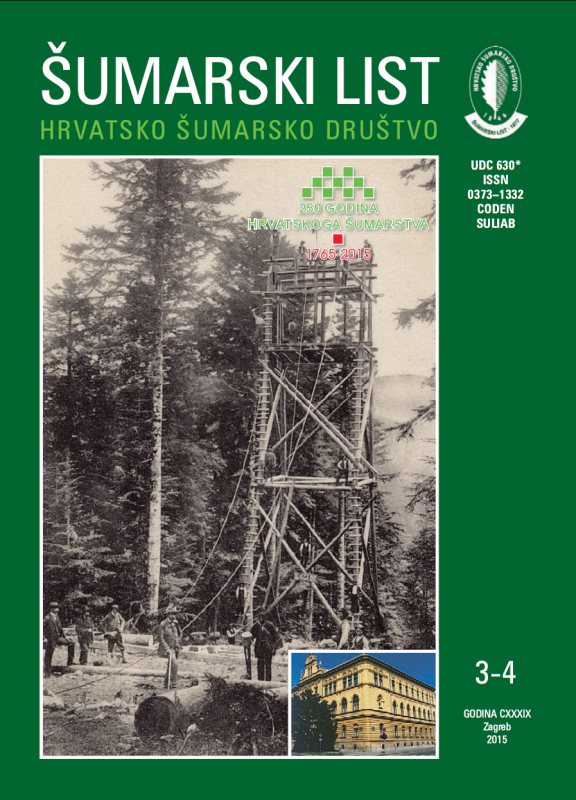
broj: 3-4/2015
pdf (4,59 MB) |
|
||||||||||||||
| RIJEČ UREDNIŠTVA | ||
| Uredništvo | ||
| FROM THE HISTORY OF FORESTRY pdf HR EN | 121 | |
| IZVORNI ZNANSTVENI ČLANCI | ||
| Ante P. B. Krpan, Željko Tomašić, Željko Zečić, Dijana Vuletić | UDK 630* 537 (001) | |
| BIOPRODUCTIVITY OF INDIGOBUSH (Amorpha fruticosa L.) IN ONE-YEAR, TWO-YEAR AND FOUR-YEAR ROTATION pdf HR EN | 123 | |
| Marijan Grubešić, Josip Margaletić, Duško Čirović, Marko Vucelja, Linda Bjedov, Jelena Burazerović, Kristijan Tomljanović | UDK630* 153 (Castor fiber L.)(001) | |
| ANALYSIS OF BEAVER (Castor fiber L.) MORTALITY IN CROATIA AND SERBIA pdf HR EN | 137 | |
| Damir Drvodelić, Tomislav Jemrić, Milan Oršanić, Vinko Paulić | UDK 630* 232.3 + 283 (001) | |
| FRUITS SIZE OF WILD APPLE (Malus sylvestris (L.) Mill.): IMPACT ON MORPHOLOGICAL AND PHYSIOLOGICAL PROPERTIES OF SEEDS pdf HR EN | 145 | |
| Vera Batanjski, Eva Kabaš, Nevena Kuzmanović, Snežana Vukojičić, Dmitar Lakušić, Slobodan Jovanović | UDK 630* 188 (001) | |
| NEW INVASIVE FOREST COMMUNITIES IN THE RIPARIAN FRAGILE HABITATS – THE CASE STUDY FROM RAMSAR SITE CARSKA BARA (VOJVODINA, SERBIA) pdf HR EN | 155 | |
| Vid Privora, Mirjana Herak Ćustić, Marko Petek, Ivan Šimić, Igor Palčić, Nikolina Sabljić | UDK 630* 272 + 114.2 (001) | |
| THE STATUS OF LAWN NUTRITION WITHIN URBAN PARKS IN PUBLIC AREAS OF THE CITY OF ZAGREB pdf HR EN | 171 | |
| Petr Zahradník, Marie Zahradníková | UDK 630* 453 (001) | |
| THE EFFICACY OF A NEW PHEROMONE TRAP SETUP DESIGN, AIMED FOR TRAPPING IPS TYPOGRAPHUS (COLEOPTERA, CURCULIONIDAE, SCOLYTINAE) pdf HR EN | 181 | |
| Summary The primary aim of this paper is to compare the efficacy of traditional set-up of pheromone traps (along a stand wall at a distance of 20 m between each other) and a new arrangement where the pheromone baited trap is placed in the middle of a stocking area with no space between single traps. A secondary aim is to find the best use of pheromone baits in trapping systems where: i) every trap is baited, ii) every second trap is baited, iii) only traps at the edges and middle of arrangements are baited. The results showed that the new organisation of pheromone baited traps is more effective than the traditional one and can provide a better tool for active forest protection in managing outbreaks of spruce bark beetles. Key words: spruce bark beetle; pheromone baited traps; spatial trap design; control | ||


